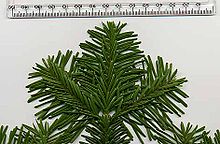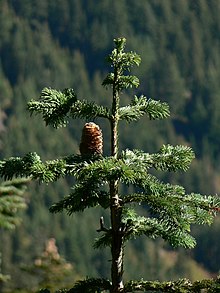Abies amabilis
| Pacific silver fir | |
|---|---|

| |
| Pacific silver fir foliage from above | |
| Scientific classification | |
| Kingdom: | Plantae |
| Clade: | Tracheophytes |
| Clade: | Gymnospermae |
| Division: | Pinophyta |
| Class: | Pinopsida |
| Order: | Pinales |
| Family: | Pinaceae |
| Genus: | Abies |
| Species: | A. amabilis
|
| Binomial name | |
| Abies amabilis | |

| |
| Range | |

Abies amabilis, commonly known as the Pacific silver fir, is a fir native to the Pacific Northwest of North America, occurring in the Pacific Coast Ranges and the Cascade Range. It is also commonly referred to in English as the white fir, red fir, lovely fir, amabilis fir, Cascades fir, or silver fir.[2][3] The species name is Latin for 'lovely'.[2]
Description[edit]
The tree is a large evergreen conifer growing to 30–45 metres (98–148 feet), exceptionally 72 m (236 ft) tall,[2] and with a trunk diameter of up to 1.2 m (3 ft 11 in), exceptionally 2.3 m (7 ft 7 in). The bark on younger trees is light grey, thin and covered with resin blisters.[4] On older trees, it darkens and develops scales and furrows. The leaves are needle-like, flattened, 2–4.5 centimetres (3⁄4–1+3⁄4 in) long and 2 millimetres (1⁄16 in) wide by 0.5 mm (1⁄32 in) thick, matte dark green above, and with two white bands of stomata below, and slightly notched at the tip.[5] The leaf arrangement is spiral on the shoot, but with each leaf variably twisted at the base so they lie flat to either side of and above the shoot, with none below the shoot. The shoots are orange-red with dense velvety pubescence. The cones are 9–17 cm (3+1⁄2–6+3⁄4 in) long and 4–6 cm (1+1⁄2–2+1⁄4 in) broad, dark purple before maturity;[4] the scale bracts are short, and hidden in the closed cone. The winged seeds are released when the cones disintegrate at maturity about 6–7 months after pollination.
The tree can live to over 400 years old.[4]
Pacific silver fir is very closely related to Maries' fir A. mariesii from Japan, which is distinguished by its slightly shorter leaves—1.5–2.5 cm (5⁄8–1 in)—and smaller cones, which are 5–11 cm (2–4+1⁄4 in) long.
Distribution and ecology[edit]
The species is native to the Pacific Northwest of North America, occurring in the Pacific Coast Ranges and the Cascade Range from the extreme southeast of Alaska, through western British Columbia, Washington and Oregon, to the extreme northwest of California. It grows from sea level to 1,000 m (3,300 ft) in the north of the range, and to 610–2,000 m (2,000–6,560 ft) in the south of the range. Populations on the east slope of the Cascades are confined to elevations above 1,000 m (3,300 ft) in Washington and 1,160 m (3,810 ft) in Oregon.[6]
It is always found in temperate rainforests with relatively high precipitation and cool, humid summers. Growing in dense stands, it prospers in shade and snow.[4] Common associate trees are western hemlock in northern ranges, Douglas-fir[4] in central areas, and California buckeye in the extreme southern area of its range.[7] Western hemlock is equally shade tolerant, but Pacific silver fir saplings are more resilient of ground obstacles.[4] Though its thin bark makes it susceptible to fire, the slow-growing saplings succeed less shade-tolerant species.[4] It survives well at high elevation, but eventually succumbs to root or heart rot, in addition to diseases and insects such as Adelges piceae.[4]
Uses[edit]
Indigenous Nations, including but not limited to the Nuxalk, Haisla, and Kitasoo Nations, used Abies amabilis or Silver Fir for medicinal purposes.[4] Ethnobotanist Daniel Moerman notes, for example, that Nuxalk Peoples mixed mountain goat tallow with liquid pitch to treat sore throat. An infusion of bark, by contrast, may have been used to address stomach issues.[8]
In addition to medicinal uses, hardened pitch of the plant was also sometimes chewed for pleasure by the Ditidaht Peoples.[8] The foliage has an attractive scent and was admired for its scent long before the arrival of European settlers in its native range. Ditidaht Peoples brought boughs into their homes as an air freshener, whereas Nlakaʼpamux Peoples boiled boughs to create unique plant-based hair perfumes.[8]
The wood is soft and not very strong; settlers thus tended to use this species for paper making, packing crates, and other cheap construction work.[4] The lumber is often paired with that of western hemlock.[4]
Seeds were not brought to England for cultivation until the 19th century. David Douglas first transported seed abroad in 1825.[4] Today, Abies amabilis or Silver Fir is sometimes planted as an ornamental tree in large parks, though its requirement for cool, humid summers limits the areas where it grows well; successful growth away from its native range is restricted to areas like western Scotland and southern New Zealand.[citation needed] Silver Fir is sometimes used for Christmas decoration, including Christmas trees.[citation needed].
References[edit]
- ^ Farjon, A. (2013). "Abies amabilis". IUCN Red List of Threatened Species. 2013: e.T42271A2968657. doi:10.2305/IUCN.UK.2013-1.RLTS.T42271A2968657.en. Retrieved 19 November 2021.
- ^ a b c "Abies amabilis". Gymnosperm Database. 2011. Retrieved December 3, 2021.
The epithet amabilis means 'lovely.
- ^ "Interactive Distribution Map of Abies amabilis". Archived from the original on 2015-10-23. Retrieved 2010-07-12.
- ^ a b c d e f g h i j k l Arno, Stephen F.; Hammerly, Ramona P. (2020) [1977]. Northwest Trees: Identifying & Understanding the Region's Native Trees (field guide ed.). Seattle: Mountaineers Books. pp. 123–128. ISBN 978-1-68051-329-5. OCLC 1141235469.
- ^ "Abies amabilis in Flora of North America @ efloras.org". www.efloras.org.
- ^ Crawford, Peggy D.; Oliver, Chadwick Dearing (1990). "Abies amabilis". In Burns, Russell M.; Honkala, Barbara H. (eds.). Conifers. Silvics of North America. Vol. 1. Washington, D.C.: United States Forest Service (USFS), United States Department of Agriculture (USDA). Retrieved 23 April 2023 – via Southern Research Station.
- ^ "California Buckeye (Aesculus californica) – photo/images/information". GlobalTwitcher.com. November 22, 2012. Archived from the original on 2012-11-22.
- ^ a b c Moerman, Daniel (2020). Native American Ethnobotany (14th ed.). Portland, Oregon: Timber Press, Inc. p. 33. ISBN 9780881924534.





